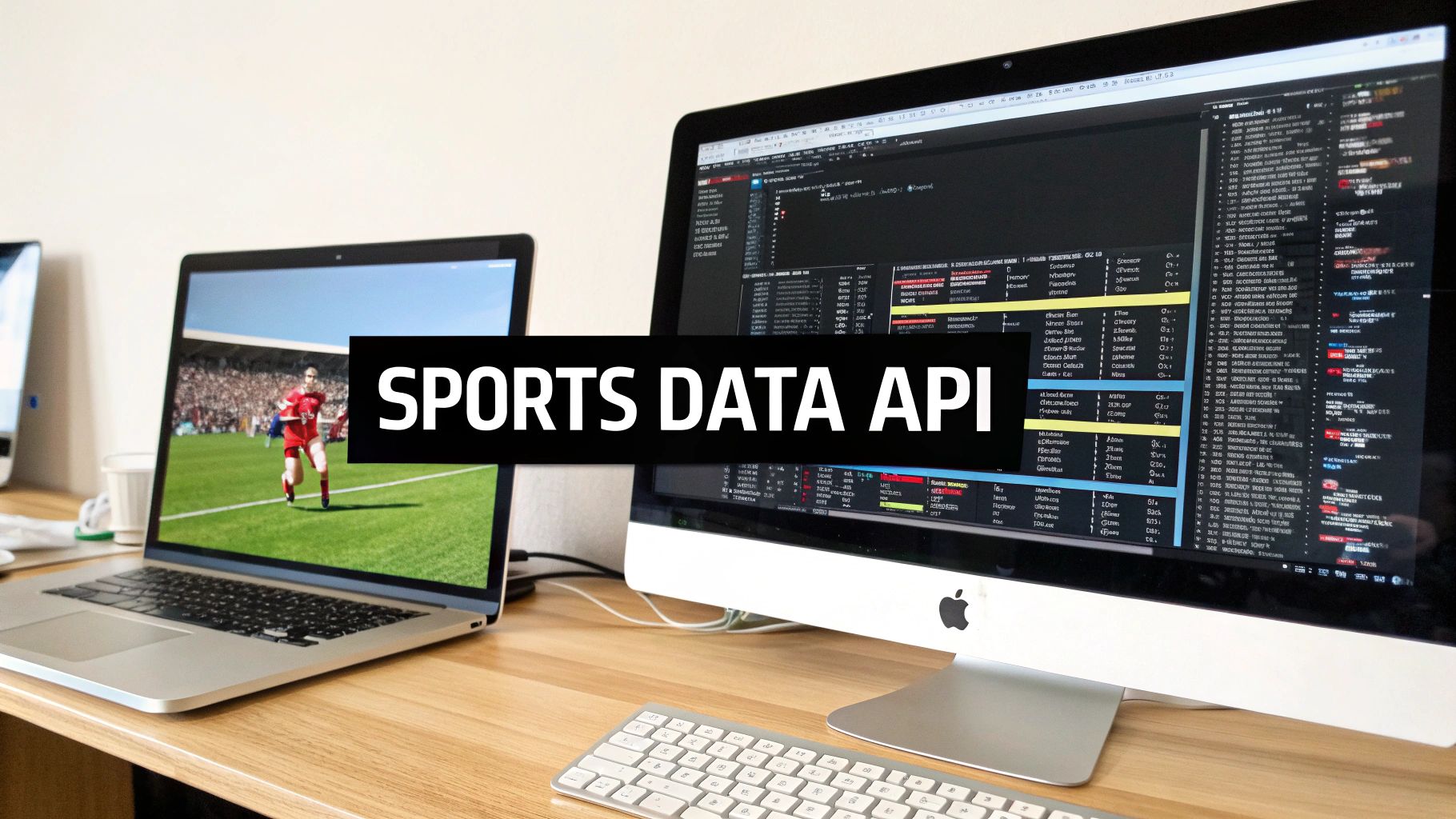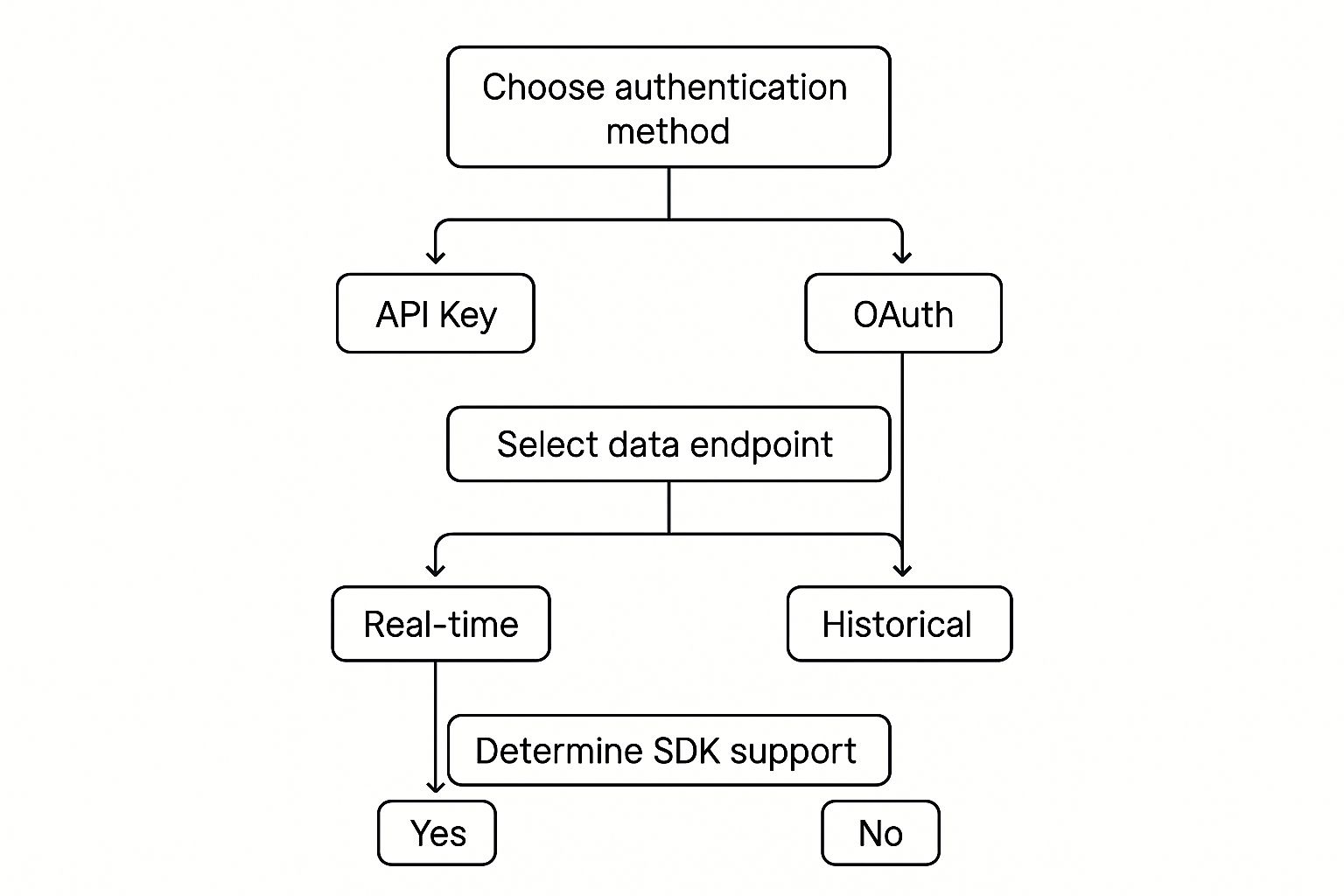
Mastering the Sports Data API
At its core, a sports data API is like a digital middleman. It’s the tool that lets developers grab live scores, player stats, and game results and feed them directly into websites and apps. Instead of having to collect and organize mountains of information themselves, they can plug into a massive, ready-made library of sports data. This is what powers everything from your favorite fantasy league to major media outlets.
What Is a Sports Data API?

The best way to think about a sports data API is to imagine it’s a specialized waiter working in a digital restaurant. You're building an app (the diner), and you need something specific, like the live score of the latest Lakers game (the meal).
Instead of running into the chaotic kitchen yourself, which in this case is the entire internet, you just give your order to the waiter (the API). That waiter knows exactly who to talk to in the kitchen and how to ask for your specific data. A few moments later, it returns with exactly what you ordered, ready to be served up to your users. Simple as that.
This tool, the Application Programming Interface, is what allows different software programs to talk to each other. A sports data API is a version of this technology built specifically to handle requests for sports information. It connects your project to a huge, constantly updated database of stats, scores, and schedules.
Breaking Down the Core Concepts
To really get a feel for how these APIs work, it helps to know a few of the key terms you'll run into. They might sound technical, but the ideas behind them are actually pretty straightforward.
When you're working with a sports data API, you'll constantly be dealing with requests, endpoints, and responses. Think of it as a simple conversation. Here’s a quick rundown of what those terms actually mean in practice.
| Term | Simple Explanation | Example in Sports |
|---|---|---|
| API Request | This is you asking the API for a specific piece of information. | "Give me the live score for the Manchester United match." |
| API Endpoint | This is the specific "address" or "location" where you send your request. | Sending your request to a URL like /live-scores/football/ |
| API Response | This is the data you get back, usually in a neat, organized format like JSON. | The API returns the current score: "Man U 2 - 1 Liverpool." |
Understanding this simple loop, request, endpoint, response, is the first step to building anything with sports data. It's the fundamental process that makes all the magic happen behind the scenes.
The demand for these services is exploding. The global sports data API market was valued at around USD 1.5 billion in 2024 and is projected to hit an incredible USD 4.2 billion by 2033. This massive growth tells you just how critical this data has become for businesses, from fan engagement platforms to serious betting analytics. You can dig into the numbers and trends driving this growth in the full research report.
Why This Technology Is a Game Changer
Imagine a world without sports APIs. Every single company wanting to display sports scores would have to build its own massive, expensive system from scratch. They’d need to track every game, every player, and every single stat in real time. It would be a nightmare of complexity and cost.
APIs completely change that equation. They make high-quality sports data accessible to everyone, from a solo developer tinkering on a passion project to a huge media company that needs rock-solid, live information.
An API gives developers a structured way to get the data they need, when they need it, without worrying about the messy details of where that data comes from or how it's collected. It's the foundation for modern sports technology.
This technology is the engine behind countless apps and has created a whole host of jobs for developers, data analysts, and engineers. If a career in this fast-growing field sounds interesting, you can check out current openings in the sports tech world by visiting www.sportsjobs.online.
By offering a simple, direct pipeline to incredibly complex data, a sports data API saves a ton of time, cuts down on costs, and throws the door wide open for innovation.
Essential Features of a Great Sports API
Picking the right sports data API feels a lot like scouting a new player for your team. You have to look past the flashy promises and get down to the fundamentals that will actually lead to success. Trust me, not all APIs are built the same, and the right features can be the difference between a game-winning project and a total bust.
So, what should you really be looking for? The absolute number one, non-negotiable feature is data accuracy. It's simple: if the scores, stats, or odds are wrong, everything you build on top of that data is worthless. A great API gives you information you can bet the house on, without ever having to second-guess it.
Core Attributes for Top Performance
Once you've confirmed the data is solid, a few other features are must-haves for any high-quality service. These are the things that define the experience for your developers and, ultimately, your users.
- Low Latency: In sports, speed is everything. An API worth its salt delivers data in real time with almost zero delay. This is crucial for things like live score tickers, in-play betting odds, and fantasy sports updates where a few seconds can literally change the outcome.
- Broad Coverage: Does the API actually cover the leagues and sports your audience cares about? A top-tier provider will offer deep coverage across a wide range of sports, giving you the flexibility to expand later.
- Clear Documentation: This is a developer's best friend. Excellent documentation isn't a "nice-to-have," it's essential. It should have clear, easy-to-follow instructions, plenty of code samples, and endpoint explanations that make sense. Without it, integration turns into a painful, time-sucking puzzle.
These are the core fundamentals. If a provider nails these, you know they're serious about quality. If you want to build your career working on these systems, check out www.sportsjobs.online for the latest opportunities.
Making Integration Smooth and Scalable
Okay, you've got the basics covered. Now it's time to look at what separates the good APIs from the truly great ones, the features that make your life easier during development and as your user base grows.
A consistent data format, which is almost always JSON (JavaScript Object Notation), is absolutely key. It guarantees that the data you get back is structured, predictable, and easy for your apps to understand and work with.
An API with a logical, consistent structure saves countless hours of development time. It allows developers to anticipate how data will be returned, which makes building and maintaining features much more efficient.
The ability to handle a ton of requests without breaking a sweat is also vital. As your app gets more popular, your API calls will skyrocket. A scalable API can take the heat without slowing down or crashing. The teams building these powerful systems need top-tier talent. For anyone interested in this space, roles like a Data Science Lead in Sports Analytics are popping up more and more, offering a chance to work right at the heart of sports tech.
Real-World Applications Powering the Industry

Think of a sports data API as the invisible engine humming behind the scenes of almost every digital sports product you use daily. It’s the critical link connecting the live, unfolding action on the field to the apps and websites we can't live without.
Whether you're checking your fantasy football scores on your phone or watching a live game tracker on a major media site, APIs are doing the heavy lifting. They pull real-time information, every single pitch, goal, or touchdown, and deliver it instantly. Without them, the dynamic, stat-heavy experiences we've all come to expect just wouldn't exist.
And the market for this tech is absolutely exploding. The global sports data API interface market, valued at roughly USD 4.5 billion in 2025, is on track to hit an estimated USD 10.2 billion by 2033. This massive growth is all thanks to the relentless demand for real-time sports insights across a ton of different industries.
Powering Fan Engagement and Media
Fantasy sports platforms are the perfect, classic example of a sports data API in action. Every single time a player scores a touchdown or smacks a home run, the API zips that update to the fantasy platform. It then crunches the numbers and displays the new point totals for millions of users in a heartbeat.
Media outlets are just as dependent on this technology. When you see a live gamecast on a news site with constantly updating stats, shot charts, and player data, that's a live API feed at work. It lets media companies create incredibly rich, engaging content without needing a whole team of people to manually type in every single play.
A powerful sports data API allows companies to build products that make fans feel closer to the action. It transforms passive viewing into an interactive, data-driven experience.
This constant need to innovate is also creating some amazing career opportunities. If building these kinds of applications sounds like your thing, you can start looking for your next role over at www.sportsjobs.online.
Fueling Betting and Professional Analytics
The sports betting industry practically runs on the speed and accuracy of API data. Betting platforms need instant, rock-solid information to set odds, manage their risk, and offer live, in-game wagering. A delay of just a few seconds can have huge financial implications, which makes a top-tier sports data API an absolute must-have.
For anyone looking to build more advanced systems, these APIs make it possible to automate data analysis for sports betting, saving a ton of time while boosting accuracy.
But it's not just about betting. Professional sports teams themselves are huge consumers of API data. They put it to work for:
- Opponent Scouting: Analysts dive deep into historical data to spot an opponent's tendencies, strengths, and exploitable weaknesses.
- Performance Analysis: Teams track their own players' performance metrics down to the finest detail to tweak training regimens and game-day strategy.
- Recruitment: Front offices use data to evaluate potential draft picks and free agents from leagues all over the globe.
From the fan refreshing their app in the stands to the GM making a blockbuster trade, sports data APIs are a fundamental tool shaping how the entire industry operates.
How to Choose the Right API Provider
Picking the right data partner is a huge decision for your business. Think of a sports data api as the very foundation of your product, if it cracks, everything you build on top of it will crumble. You need a provider you can actually trust. It’s about more than just the data; you have to look at their pricing, support, and the fine print in their service terms to find a partner that truly fits your project.
What's This Going to Cost Me?
First things first, let's talk about the money. API providers have a few different ways they charge for their services, and the best one for you comes down to your budget and how you plan to use the data.
- Pay-As-You-Go: This model is exactly what it sounds like, you pay for the API calls you make. It’s a fantastic option if your traffic is all over the place or you're just dipping your toes in the water.
- Subscription Tiers: Many providers offer monthly or annual plans with a set number of requests included. If your traffic is fairly steady, this is ideal because it makes budgeting a whole lot simpler. No surprises at the end of the month.
- Freemium: Some companies will give you a free tier with basic access. This is perfect for testing the waters or for small, non-commercial projects. Just keep a close eye on the limitations so you don't hit a wall unexpectedly.
Support and Technical Reliability
Great data is only half the battle. When things inevitably go sideways, and they will, you need to know there's a reliable team ready to help you out. Dig into the provider’s customer support. Can you get a quick email response, or do they offer a dedicated Slack channel for developers?
This is also where you need to get serious about the Service Level Agreement (SLA). An SLA isn't just jargon; it's a formal promise from the provider about the API's performance, especially its uptime. A provider that guarantees 99.9% uptime is making a serious commitment to being reliable.
Don’t just take their word for it. The best way to evaluate a sports data API is to get your hands dirty and actually use it. Take full advantage of any free trials or sandbox environments. Run your own tests, check the data quality for yourself, and see how it performs under real-world pressure before you sign any contracts.
This hands-on testing phase is non-negotiable. It’s where you’ll spot potential headaches with data formatting or slow response times before they become a massive problem for your users. Honestly, it's a critical step in building a successful product and, frankly, a solid career. If you're looking to build a career in this space, you can find jobs in the sports tech industry at www.sportsjobs.online.
The infographic below gives you a simple decision path for the common technical choices you'll face when you start an integration.

This visual guide helps break down those initial tech decisions, like whether to use API keys or OAuth for security and if you need real-time or historical data based on what you're building.
To help you keep track of everything, I've put together a simple checklist for comparing providers side-by-side.
API Provider Comparison Checklist
| Evaluation Criteria | Why It Matters | What to Look For |
|---|---|---|
| Data Coverage & Quality | The data is your product's core. Inaccurate or incomplete data makes your app useless. | Check for specific leagues, sports, and data points (live scores, historical stats). Look for positive reviews on data accuracy. |
| Pricing Model | Your budget and usage patterns will determine the most cost-effective plan. | Does the model scale with your growth? Are there hidden fees? Compare Pay-As-You-Go vs. Subscription costs for your expected usage. |
| Documentation | Clear documentation saves you hours of frustration and speeds up development. | Is it well-organized and easy to read? Are there code examples in your preferred language? Is there a "getting started" guide? |
| Uptime & Reliability (SLA) | Downtime means your application is dead in the water, which damages user trust. | Look for a formal SLA with a high uptime guarantee (e.g., 99.9%). Check for a public status page. |
| Customer Support | When you hit a roadblock, fast and knowledgeable support is a lifesaver. | What are the support channels (email, chat, phone)? What are the guaranteed response times? Are there different support tiers? |
| Free Trial / Sandbox | This is your chance to test everything before you commit your time and money. | Does the trial offer access to the full API? Are there limitations on API calls or data access? Is it easy to sign up? |
Using a checklist like this ensures you're making an informed, apples-to-apples comparison instead of just going with the first provider you find. It forces you to think through what really matters for your specific project.
The Growing Impact of E-Sports Data

It wasn't long ago that e-sports was just a niche hobby. Now, it's a global powerhouse, and the demand for data is just as fierce as it is in traditional sports. Competitive gaming pumps out a constant stream of unique information that goes way beyond simple wins and losses. To make any sense of it, a specialized e-sports sports data API is absolutely essential.
Think about it: unlike a basketball or football game, e-sports can generate thousands of data points every single second. This information is the lifeblood for everything from live broadcasts to a pro team's next strategic move. For anyone looking to build a career in this space, the opportunities are popping up daily. You can start looking for your opening right now at www.sportsjobs.online.
Specialized Data in Competitive Gaming
E-sports data is incredibly detailed. We're talking about capturing every single in-game action, from a player's mouse clicks and keyboard inputs to their strategic positioning on the map. This gives us a level of insight that's almost impossible to replicate in most traditional sports.
Just a few examples of key e-sports data points include:
- Player Actions Per Minute (APM): A direct measure of a player's raw mechanical skill and how quickly they react.
- In-Game Events: Tracking major objectives, like destroying a tower in League of Legends or planting the bomb in Counter-Strike.
- Champion or Character-Specific Stats: Breaking down performance with specific characters, how much damage they dealt, healing they did, and how effectively they used their abilities.
This firehose of rich data is what makes the entire e-sports ecosystem tick, powering everything from analytics to the fan experience.
The global e-sports data API market is blowing up, with some forecasts estimating it will hit a valuation of around $1.5 billion by 2025. This isn't just hype; it reflects real audience engagement and massive commercial opportunities.
This incredible growth is fueled by big investments from both tech companies and traditional sports organizations that see the writing on the wall. Major tournaments are pulling in millions of viewers, which in turn drives the demand for more detailed, real-time performance data. To get a better sense of this trend, you can discover the full research on e-sports data APIs.
How E-Sports Data Shapes the Experience
So, what happens to this constant stream of information? It gets put to use in some really cool ways. On streaming platforms like Twitch, an API can feed data directly into live broadcast overlays. This shows viewers real-time stats about the players and the state of the match, adding a layer of depth that makes the games more thrilling to watch and easier for newcomers to understand.
Professional teams are also completely reliant on this data. Coaches and analysts use a sports data API to pore over past performances, scout their opponents, and cook up winning strategies backed by hard evidence. It’s an indispensable tool for anyone looking for a competitive edge.
Your First Steps to Integrating an API
Getting your hands dirty with a sports data API might sound intimidating, but the core process is surprisingly simple. We're going to walk through the universal steps to make your first data request, taking you from theory to a real, tangible result. Don't worry about the programming language for now, we're focused on the concepts.
Your first move is always to sign up with an API provider to get your unique API key. Think of this key as your personal password or a digital ID badge. It tells the provider's server who you are and tracks your usage, so it’s critical to keep it private and secure.
Making Your First API Call
Once you have your key, it's time to dive into the API's documentation. This is your instruction manual. Seriously, don't skip this. Getting familiar with API documentation best practices will save you a ton of headaches down the line. Good docs will clearly lay out all the available endpoints, the specific URLs you'll use to request different types of data.
An API endpoint is like a specific phone number for the information you need. You dial the number for "live NFL scores," not the one for "historical NBA stats," to get the right response.
To make a request, you'll put together a simple query. This usually means combining the API's base URL, the specific endpoint you want to hit, and your API key as a parameter. It’s a process that requires a sharp eye for detail. In the real world, specialized roles like a DevOps Engineer are dedicated to managing these kinds of integrations, making sure all the different systems can talk to each other without a hitch.
Handling the Data Response
After you send your request, the API fires back a response. Almost every time, this will be in a format called JSON. A JSON object is just a structured, organized collection of the data you asked for, think of it as a neatly organized digital filing cabinet.
Your final step is to write a little bit of code to parse this response. That just means sifting through the JSON to pull out the exact pieces of information you need, like team names and their current scores, so you can display them in your app.
And that's it! You've just made your first successful API call. This fundamental loop, request and response, is the building block for any feature you can imagine creating with a sports data API.
Frequently Asked Questions
Thinking about using a sports data API? You're not the only one. Let's tackle some of the most common questions that pop up for developers and businesses before they dive in.
How Much Does a Sports Data API Typically Cost?
This is a big one, and the honest answer is: it varies wildly. Many providers offer a free tier, which is fantastic for getting your feet wet, testing an idea, or powering a small personal project. These usually come with a limited number of requests.
Once you need more power, paid plans can kick in at around $50 a month for basic access. For the big leagues, enterprise-level service with massive request volumes, deep historical data, and the super-fast, low-latency feeds that media outlets and betting companies rely on, you could be looking at thousands per month.
Can I Legally Use API Data for My Application?
Yes, you can, but this comes with a big, bold "but." You absolutely must read the provider's terms of service. Most will offer commercial licenses that give you the green light to use their data in for-profit apps. However, there are almost always rules to follow.
For instance, a provider might forbid you from simply reselling their raw data. Others might require you to display their logo somewhere on your site as attribution. Before you write a single line of code, always double-check the usage rights to make sure your project is playing by the rules. For a deeper look into the legal side of things, you can check out our guide on sports data regulations.
What Technical Skills Do I Need?
You'll need a handle on some programming basics. At a minimum, you should be comfortable making HTTP requests in a language like Python, JavaScript, or Java. You also have to know how to work with JSON, as it's the standard data format for just about every modern API out there.
You don't need to be a senior-level developer to get started, but understanding the fundamentals of how APIs work is crucial. The good news is that many providers make this easier by offering code snippets and even software development kits (SDKs). Building these skills is a great career move, too. If that piques your interest, you can always look for opportunities on www.sportsjobs.online.
Hundreds of jobs are waiting for you!
Subscribe to membership and unlock all jobs
Sports Analytics
We scan all major sports and leagues
Updated Daily
New jobs are added every day as companies post them
Refined Search
Use filters like skill, location, etc to narrow results
Alerts
You can get daily alerts in your email for a specific search
Access to job postings from top teams and companies
Daily updates and notifications based on your preferences
🎯 Over 90% of customers chose to renew their subscriptions after the initial sign-up
Monthly
$6.99
per month
✓ Flexible monthly billing
✓ Unlimited access to all jobs
✓ Advanced filtering tools
✓ Daily job alerts
✓ Exclusive discount codes
✓ Cancel anytime
BEST VALUE
Yearly
$39
per year • Only $3.25/mo
✓ Save 50% vs monthly
✓ Unlimited access to all jobs
✓ Advanced filtering tools
✓ Daily job alerts
✓ Exclusive discount codes
✓ Cancel anytime
Lifetime
$59
one-time • forever
✓ Pay once, access forever
✓ Unlimited access to all jobs
✓ Advanced filtering tools
✓ Daily job alerts
✓ Exclusive discount codes
✓ Best long-term value